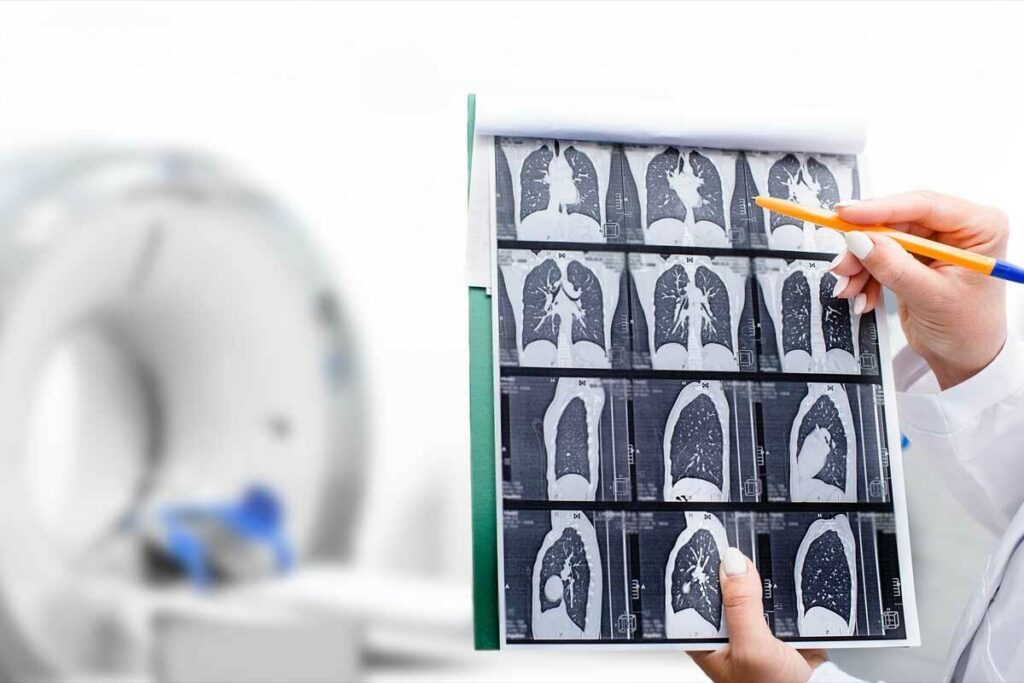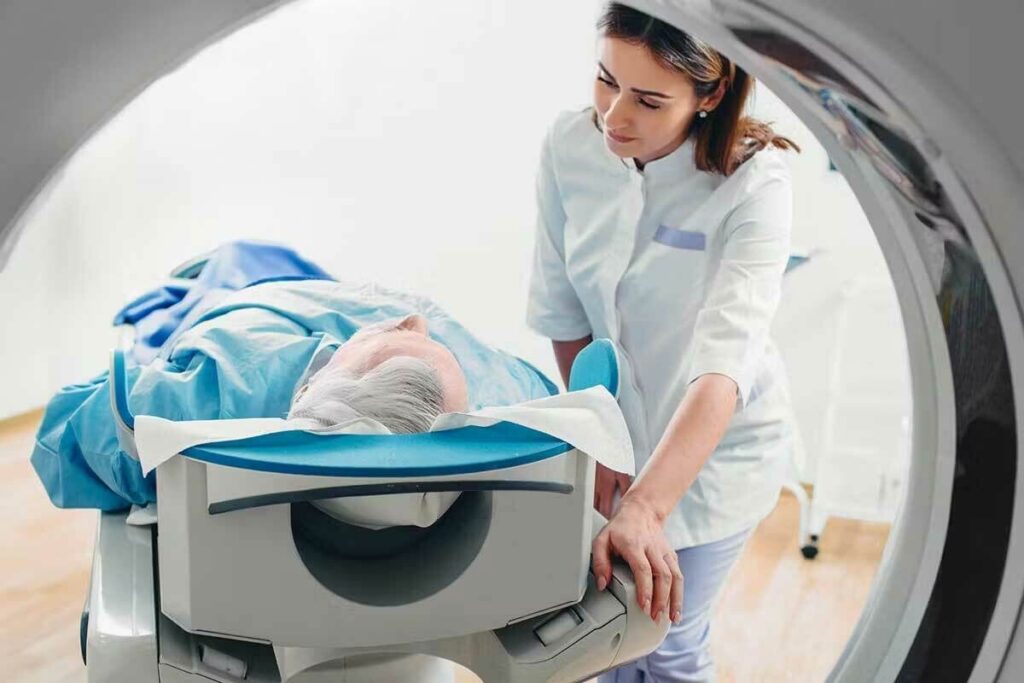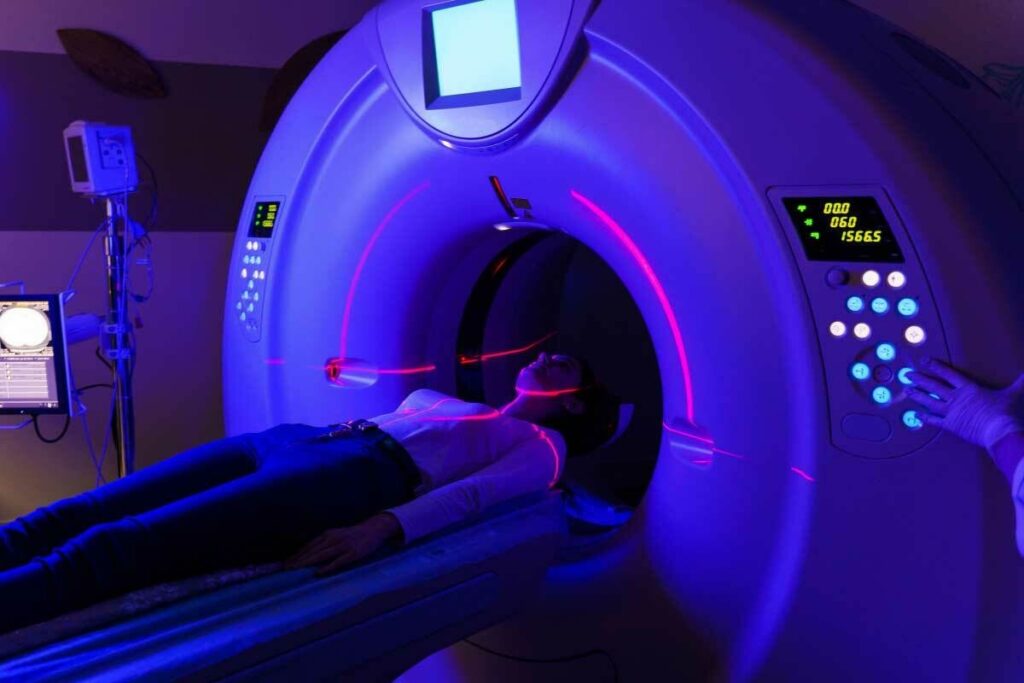
At Liv Hospital, we know how vital accurate diagnosis is for cancer treatment. Computed Tomography (CT) scans have changed medical imaging. They help doctors spot tumors and growths with great detail.
CT scans make detailed pictures of the body. They show the size, shape, and where tumors. This info is key for figuring out cancer’s stage and planning treatment.
We trust CT scans at Liv Hospital for diagnosing and keeping an eye on cancer patients. Though CT scans are very useful, it’s important to know their limits and how accurate they are for different cancers.

CT scans use X-rays to make detailed images. They are key in modern medicine. They give clearer images than regular X-rays, helping find cancers and other issues.
CT scans mix X-rays and computer tech for body images. They rotate an X-ray source and detectors around the patient. This captures data from many angles.
Then, they use complex algorithms to make detailed images from this data.
Key steps in creating CT images include:
CT scans are different from MRI and PET scans. MRI uses magnetic fields and radio waves. CT scans use X-rays. This makes CT scans great for some tasks.
“CT scans are very useful in emergencies when quick and accurate images are needed.”
Medical Imaging Expert
Here’s a comparison of CT scans with other imaging methods:
| Imaging Method | Primary Use | Technology Used |
| CT Scan | Cancer detection, trauma assessment | X-rays |
| MRI | Soft tissue evaluation, neurological disorders | Magnetic fields and radio waves |
| PET Scan | Cancer staging, metabolic activity assessment | Radioactive tracers |
Knowing the strengths and limits of each imaging method is key to accurate diagnosis and treatment planning.

CT scans are key in finding cancer because they show abnormal tissue and tumors. They make detailed pictures of the body’s inside. This helps us spot and keep track of health issues, like cancer.
CT scans use X-rays to see inside the body. When done, they show where tissue is not normal. This is important for catching cancer early.
Tumors are usually denser than healthy tissue. CT scans can spot these differences. This means they can find tumors in places like the lungs, liver, and colon before symptoms show.
| Organ | Typical Tumor Density | Detectability by CT Scan |
| Lungs | Soft tissue density | High |
| Liver | Variable density | Moderate to High |
| Colon | Soft tissue density | High |
CT scans are great at showing abnormal tissue and tumors. They help find cancer early. Early detection is essential for treating cancer well, and CT scans are a big help.
CT scans are key in finding cancers early. This can lead to better treatment results. They give us detailed views of the body, spotting tumors and issues not seen by other methods.
Lung cancer is a big problem globally. CT scans are vital in finding it. They are suggested for those who smoke or have a family history of lung cancer. They can spot lung nodules early.
The National Cancer Institute says CT scans find lung cancer sooner than X-rays. This can help people live longer.
CT scans are also good for finding liver and pancreatic cancers. They show the size and where tumors are. This is key to choosing the right treatment.
For liver cancer, CT scans can spot tumors as small as 1 cm. For pancreatic cancer, they help see how tumors affect nearby areas.
While colonoscopy is the top choice for colorectal cancer screening, CT scans are useful too. They help find colorectal cancer, even if it has spread. CT scans show the main tumor and any cancer in the lymph nodes or other organs.
In summary, CT scans are a big help in finding cancers like lung, liver, pancreatic, and colorectal. Their detailed images are vital for diagnosing and planning treatment.
It’s key to know how well CT scans find different cancers. This helps doctors diagnose and plan treatments. The accuracy of CT scans changes with the cancer type and stage.
When we talk about CT scan accuracy, we look at sensitivity and specificity. Sensitivity is about catching cancer correctly. Specificity is about not missing those without cancer.
CT scans find cancers at different rates. For example:
Many things affect how well CT scans find cancer. These include tumor size, where it is, and if it has spread.
Many things can change how accurate CT scans are for cancer. These include:
Knowing these factors helps us see what CT scans can do well and what they can’t.
CT scans are key in finding cancer, working best under certain conditions. Their success in spotting cancer depends on several things. These include the cancer type, where it is, and the scanner technology.
To get the most from CT scans in cancer detection, some conditions must be met. These include:
Table: Factors Influencing CT Scan Accuracy
| Factor | Description | Impact on Accuracy |
| Scanner Resolution | High-resolution scanners give clearer images. | Helps spot smaller tumors more accurately. |
| Contrast Agents | Contrast agents make tumors easier to see. | Boosts tumor detection, mainly in soft tissues. |
| Radiologist Expertise | Skilled radiologists interpret scans better. | Reduces errors in tumor detection. |
Some cancer traits make them easier to spot on CT scans. These include:
Knowing these factors and traits helps doctors use CT scans better. This leads to more precise diagnoses and better treatment plans.
CT scans are great for finding cancer, but they’re not perfect. Knowing their limits helps us get a better diagnosis. They show us the inside of our bodies, but some things can make it hard to see cancer.
CT scans struggle with small tumors. Tumors under 1 cm are hard to spot, mainly because they blend in with the tissue around them. Early cancers, like prostate or uterine, might not show up on a CT scan until they grow bigger.
Studies show some cancers, like early prostate or uterine cancer, can slip past CT scans. This is often because they’re tiny or in tricky spots to see.
The body’s shape can also make it tough for CT scans. Areas with lots of bones or dense tissue are harder to see. Places like the pelvis or the base of the skull are “blind spots” because of their complex anatomy and the chance for artifacts.
Things like moving during the scan or having medical implants can mess with the image quality. These issues can hide tumors from view.
Some cancers are tougher to spot on CT scans than others. For example, cancers that spread out or don’t change the tissue around them are hard to find. Lymphoma and some leukemia types might not show up on a CT scan until they’ve caused big changes in organs.
It’s key to know these limits when looking at CT scan results. CT scans are valuable, but they should be used with other tests and doctors’ opinions for the best diagnosis.
CT scans are a common tool for finding cancer. But how do they stack up against MRI and PET scans? Each imaging method has its own strengths and weaknesses. Knowing these differences helps doctors choose the best test for each patient.
CT scans and MRI are both useful for finding tumors. MRI is better at showing soft tissues, like the brain and liver. CT scans, on the other hand, are great for the lungs and are quicker, making them better for emergencies.
Key differences between CT and MRI include:
PET scans are also key in cancer diagnosis, often paired with CT scans. CT scans show the body’s structure, while PET scans reveal metabolic activity. Together, they help spot cancer, track its spread, and check how treatments are working.
The advantages of PET-CT include:
Even with CT scans, more tests might be needed to confirm a diagnosis. This could include MRI, PET scans, or biopsies. The choice depends on the initial findings, the suspected cancer type, and the patient’s health.
The decision to proceed with additional testing is typically made when:
CT scans are key in cancer staging. They give doctors detailed images of cancer spread. This info is vital for picking the right treatment.
CT scans help sethe e the tumor size and how it affects nearby tissues. They check if cancer has spread to lymph nodes or other parts of the body.
Key factors assessed during a CT scan for cancer staging include:
| Cancer Stage | CT Scan Findings | Treatment Implications |
| Localized | Tumor confined to the original site | Surgery or localized radiation |
| Regional | Spread to nearby lymph nodes | Combination therapy, including surgery and radiation |
| Distant | Metastasis to distant organs | Systemic treatments like chemotherapy |
CT scans’ findings on cancer spread guide treatment plans. Accurate staging helps choose between local treatments like surgery or radiation and systemic treatments like chemotherapy.
CT scans give a clear view of cancer extent. This helps doctors create targeted and effective treatment plans. It improves patient outcomes.
CT scans are key in checking how well cancer treatments work. They give detailed images that help doctors see how tumors change over time.
CT scans mainly track changes in tumor size. If a tumor shrinks, it means the treatment is working. But if it stays the same or grows, the treatment might not be effective. They also look at changes in tumor density or if there’s necrosis.
Recent studies show that CT scans can accurately measure tumor size changes. This helps doctors spot if treatment is working or not early on. This info is key for adjusting treatment plans on time.
CT scans are also important for finding cancer that has come back. After treatment, patients get regular CT scans to watch for recurrence. Finding cancer early can greatly improve treatment results.
Medical experts say that
“Regular follow-up CT scans are essential for the early detection of cancer recurrence, allowing for prompt intervention,”
this can lead to better patient outcomes.
The timeline for follow-up imaging depends on the cancer type, stage, and treatment. Usually, CT scans are done every 3-6 months to check for recurrence or spread.
We work with patients to find the best follow-up schedule for them. This approach ensures they get the right care without too much radiation.
By using CT scans to monitor treatment and find recurrence, we offer care that fits each patient’s needs.
CT scans are key to finding cancer early. But, they also come with risks. The good news is that the benefits often outweigh the risks, which is important for cancer diagnosis and treatment.
CT scans use X-rays to see inside the body. This means they expose us to radiation. This exposure might raise the chance of getting cancer. Scientists are always studying this risk.
Key factors influencing radiation risk include:
Young people are more at risk because their bodies are growing. This makes it important to think carefully before doing CT scans on kids.
Contrast media is another thing to watch out for. It’s usually safe bu,t can cause problems in some people. These problems can be mild, like hives, or serious, like anaphylaxis.
Precautions for contrast media use include:
Even with risks, CT scans are very useful. It’s all about finding the right balance. This means:
By managing these things, doctors can make sure CT scans help a lot while keeping risks low.
CT technology has made big strides, playing a key role in finding and treating cancer. New features like low-dose CT scans and Artificial Intelligence (AI) are changing cancer care. Low-dose CT scans give clear images but use much less radiation, perfect for regular checks, like for lung cancer.
AI helps analyze images better, making cancer detection more accurate and reducing mistakes. It can spot patterns and oddities in CT images that humans might miss. For more on CT scans in cancer detection, CT technology’s growth is making cancer care better, giving patients new hope. As it keeps improving, we’ll see even better tumor detection and treatment, leading to better care for all.
Yes, CT scans can find different kinds of cancer. They make detailed images that show abnormal tissues and tumors.
CT scans can spot lung, liver, pancreatic, and colorectal cancers. They do this by showing differences in tissue density.
CT scan accuracy depends on the cancer type. Things like sensitivity and tumor size play a big role.
Yes, CT scans might miss cancer. This is more likely if tumors are small or hard to see in certain areas.
CT scans have limits. They can miss small tumors or struggle with certain types of cancer. Anatomical challenges also play a part.
CT scans have their own strengths and weaknesses compared to MRI and PET scans. Each method has its own benefits in different situations.
CT scans are key in figuring out how far cancer has spread. This information is vital for treatment planning.
Yes, CT scans help track how well treatment is working. They measure tumor size and detect any signs of cancer coming back.
Yes, CT scans carry risks like radiation exposure and reactions to contrast media. It’s important to weigh these risks against the benefits.
CT technology is getting better with higher image quality and new scanning methods. Artificial intelligence is also being used to improve cancer detection and management.
CT scans can show cancer, but it depends on several factors. These include the cancer type, stage, and scan quality.
Yes, many cancers can be found with CT scans. They provide important information for diagnosis and treatment planning.
CT scans can find various cancers, like lung, liver, pancreatic, and colorectal cancers. They help visualize tumors and assess their characteristics
Subscribe to our e-newsletter to stay informed about the latest innovations in the world of health and exclusive offers!
WhatsApp us